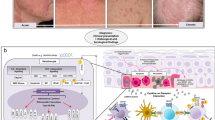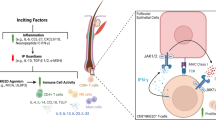Abstract Epidermal basal cell injury with colloid body formation is a characteristic feature of lichen planus. Infiltrated cells are thought to be responsible for the epidermal injury. Ultrastructural findings of colloid bodies are typical of apoptosis. Granzymes in cytotoxic T lymphocytes are involved in apoptosis probably together with perforin. Based on this background, we analyzed the role of granzyme B in the mechanisms of epidermal injury in lichen planus. On electron microscopy, basal and suprabasal cells showed condensed chromatin and fragmented nuclei which are typical morphological features of apoptosis. Nuclei of colloid bodies were positively stained by the in situ nick end labeling technique indicating that colloid bodies are subsequently formed in the process of apoptosis. Immunohistochemical staining showed CD8-positive infiltrating cells to contain granzyme B. Cells undergoing exocytosis also contained granzyme B. By immunoelectron microscopy, granzyme B molecules were observed to be secreted from a lymphocyte to an apoptotic keratinocyte. These findings suggest that granzyme B-positive CD8 cells seem to induce apoptosis of keratinocytes in lichen planus.
Similar content being viewed by others
Author information
Authors and Affiliations
Additional information
Received: 3 September 1996
Rights and permissions
About this article
Cite this article
Shimizu, M., Higaki, Y., Higaki, M. et al. The role of granzyme B-expressing CD8-positive T cells in apoptosis of keratinocytes in lichen planus. Arch Dermatol Res 289, 527–532 (1997). https://doi.org/10.1007/s004030050234
Issue Date:
DOI: https://doi.org/10.1007/s004030050234




